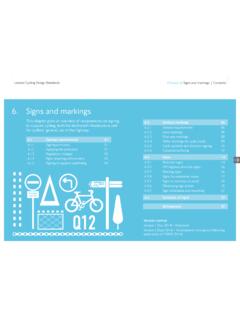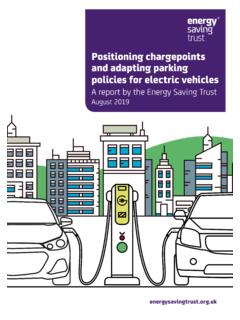Transcription of Traffic Signs Manual - Chapter 1 Introduction - GOV.UK
1 1. Traffic Chapter . Signs Manual Introduction 2018. Traffic Signs Manual Chapter 1. Introduction Department for Transport Department for Infrastructure (Northern Ireland). Scottish Government Welsh Government London: TSO. Traffic Signs Manual Contents of Chapters 1 8. Chapter 1 Introduction Chapter 2 Informatory Signs *. Chapter 3 Regulatory Signs Chapter 4 Warning Signs Chapter 5 Road Markings Chapter 6 Traffic Control Chapter 7 The Design of Traffic Signs Chapter 8 Traffic Safety Measures and Signs for Road Works and Temporary Situations * To be published at a later date Designers should consult the Department for Transport's website for confirmation of current publication dates. Published for The Department for Transport under licence from the Controller of Her Majesty's Stationery Office. Crown copyright 2018. All rights reserved Copyright in the typographical arrangement rests with the Crown.
2 This publication, excluding logos, may be reproduced free of charge in any format or medium for non-commercial research, private study or for internal circulation within an organisation. This is subject to it being reproduced accurately and not used in a misleading context. The copyright source of the material must be acknowledged and the title of the publication specified. First published 2018. First edition Crown Copyright 1977. ISBN 978 0 11 553601 4. Printed In the united kingdom for TSO (The Stationery Office). J003507060 c2 11/18. CONTENTS. 1 Introduction 5. Overview 5. Definitions 6. Responsibility 6. References 7. Format 7. Further information 8. 2 THE GOLDEN RULES 9. General 9. Standardisation of Traffic Signs 9. Reducing sign clutter 10. Duplication of regulatory Signs 11. 3 LEGAL ASPECTS AND RESPONSIBILITIES 12. Responsibility 12. Legal framework 12. Location 12.
3 Removing unlawful Traffic Signs 13. 4 CLASSIFICATION OF Signs 14. General 14. Warning Signs 14. Regulatory Signs 15. Informatory, directional and tourist Signs 16. Design of Signs 18. 5 POSITIONING OF Signs 20. General 20. Siting along the road 20. Lateral placement 21. Mounting heights 22. Orientation 22. 6 MOUNTING Signs 24. Support structures 24. Design of support structures 24. Multiple Signs on a support structure 25. 7 sign BACKGROUNDS 27. General 27. Backing boards 27. 8 MAINTENANCE OF Signs 29. General 29. 9 REMOVING Signs AND SUPPORTS 31. General 31. 10 SPECIFICATION FOR Signs 32. General 32. 11 ILLUMINATION OF Signs 33. General 33. Legislation 33. Lighting and reflectorisation 35. Road markings 35. 12 SOURCES OF FURTHER ADVICE 36. General 36. Design Manual for Roads and Bridges (DMRB) 36. Manual for Streets 36. Institute of Highway Engineers guidance 36. APPENDIX A 37.
4 Standard colours for Traffic Signs 37. Standard colours for road markings 37. APPENDIX B 38. British Standards for Traffic Signs 38. British Standards for road marking materials 38. Other relevant British Standards 38. LIST OF FIGURES 40. INDEX 41. 4. 1 Introduction . 1 3 4 5 6 7 8. Traffic Traffic Traffic Traffic Traffic Traffic Traf fic Chapter . Chapter . Chapter . Chapter . Chapter . Chapter . Chapter . Signs Signs Signs Signs Signs Signs Signs ManualManual Manual Manual Manual Manual Manual Introduction Regulatory Signs Warning Signs Road Markings Traffic Control The Design of Traffic Signs 2018 2018 2018 2018 2018 2018. Overview The Traffic Signs Manual (the Manual ) offers advice to Traffic authorities and their contractors, designers and managing agents in the united kingdom , on the use of Traffic Signs and road markings on the highway network. Mandatory requirements are set out in the Traffic Signs Regulations and General Directions 2016 (as amended) (TSRGD).
5 In Northern Ireland the relevant legislation is the Traffic Signs Regulations (Northern Ireland) 1997 (as amended). Whilst the Manual can assist with complying with the mandatory requirements, it cannot provide a definitive legal interpretation, nor can it override them. This remains the prerogative of the courts or parking adjudicators in relation to the appearance and use of specific Traffic Signs , road markings etc. at specific locations. The advice is given to assist authorities in the discharge of their duties under section 122 of the Road Traffic Regulation Act 1984 and Part 2 of the Traffic Management Act 2004 in England and under Part 1 of the Roads (Scotland) Act 1984. Subject to compliance with the Directions, which are mandatory (see and ), it is for Traffic authorities to determine what signing is necessary to meet those duties. It includes advice on the use, siting, and illumination of Traffic Signs and road markings on all purpose roads and motorways, as well as temporary Signs for use in connection with road works and in emergency situations by the police.
6 Reducing sign clutter was a key aim of the revision of TSRGD. The guidance on decluttering in the Manual has been strengthened to reflect the changes in TSRGD, acknowledging the work of the Road Signs Task Force led by Sir Alan Duncan. Following the advice in the Manual can help Traffic authorities reduce the amount of sign clutter on their roads. The Manual applies to the united kingdom . References to the national authority should therefore be interpreted as referring to the Secretary of State for Transport, the Department for Infrastructure (Northern Ireland), the Scottish Government or the Welsh Government as appropriate. Any reference to the Department is a reference to the Department for Transport or the appropriate national authority for Northern Ireland, Scotland or Wales as described above. 5. Introduction . Definitions In the Manual , the word must is used to indicate a legal requirement of the Traffic Signs Regulations and General Directions (or other legislation) that must be complied with.
7 The word should indicates a course of action that is recommended and represents good practice. The word may generally indicates a permissible action, or an option that requires consideration depending on the circumstances. Section 64 of the Road Traffic Regulation Act 1984 defines a Traffic sign as any object or device (whether fixed or portable) for conveying to Traffic on roads or any specified class of Traffic , warnings, information, requirements, restrictions or prohibitions of any description . and any line or mark on the road for so conveying such warnings, information, requirements, restrictions or prohibitions and stipulates that these Signs be specified by regulations made by the national authority, or authorised by the national authority . The types of Signs and carriageway markings and their appropriate use are prescribed in TSRGD. Signing includes not only Traffic Signs mounted on supports (and other structures such as gantries, bridges, railings, etc) but also carriageway markings, beacons, studs, bollards, Traffic signals, matrix signals and other devices prescribed in TSRGD.
8 Responsibility Traffic Signs are placed by the Traffic authority, through the powers provided by the Road Traffic Regulation Act 1984, to provide warnings, information and details of restrictions to road users. The police and certain other public bodies and statutory authorities also have the right to place Traffic Signs , but only in the limited circumstances provided for by the relevant legislation. In order to achieve safe and efficient operation of a highway network, it is essential that all signing provided is necessary, clear and unambiguous, and gives its message to road users at the appropriate time. The message must be quickly and easily understood at the point it is needed; neither too soon that the information might be forgotten, nor too late for the safe performance of any necessary manoeuvre. Engineers who design and maintain the road network must be able to offer consistent standards that can satisfy the road user's need for information and guidance.
9 Traffic authorities depend on signing for the efficient control and movement of Traffic , for enforcement of Traffic regulations and, most importantly, as an aid to road safety. It is therefore recommended that all major Traffic signing work should have been designed or checked by someone with an appropriate qualification. An example qualification would be the Institute of Highway Engineers' Professional Certificate in Traffic sign Design that allows applicants to demonstrate their experience and produce work to the required standard. A designer holding a Practitioner or Expert level Certificate would be likely to demonstrate the skills needed to adequately check Traffic signing work. For more information please see: In describing the design and use of Signs , mention is made of the definitions listed in Table 1-1. These are all elements that must be considered during the design stage of the signing process to ensure Signs are seen accurately by drivers, within the appropriate time frame and to maintain road safety.
10 6. Introduction . Table 1-1 Definitions sign legibility The attributes of a sign face that allows recognition of its text characters, numerals and symbols. It is affected by the choice and size of type face, the contrast between colours and the amount of light reaching the observer from the sign . It directly relates to an observer's visual acuity. Legibility The furthest distance at which a sign is legible determines the time available for a driver to distance read its message, taking account of the speed at which they are travelling. Readability The character of a sign that leads to comprehension of its intended message. This depends on legibility, its layout and spacing, the clarity and ease of recognition of any symbology, the amount of information it contains, and the time available to read it. It is considered a subjective outcome. Conspicuity The capacity of a sign to stand out or be distinguishable from its surroundings and thus be readily discovered by the eye.












